How Ticks Evaluates Companies and Reports on Their Human Rights Credentials
Ticks is a consumer-focused organisation that provides independent evaluations of business practices across key ethical domains. One of its core areas of assessment is human rights. As global supply chains grow in complexity, and social issues like forced labor, discrimination, and privacy violations gain greater attention, there is increasing pressure on businesses to demonstrate real, accountable human rights performance. Ticks provides a reliable framework to help consumers, investors, and stakeholders assess how seriously companies uphold and protect human rights.
Through thorough research, data-driven scoring, and transparent reporting, Ticks helps expose abuses, reward ethical leadership, and empower consumer choice in favor of social justice.
1. Mission and Ethical Foundations
Ticks’ human rights assessment mission is grounded in the principles of the Universal Declaration of Human Rights, ILO Core Conventions, and the UN Guiding Principles on Business and Human Rights. Its evaluations are built on the following principles:
- Accountability: Businesses must be accountable for all operations and impacts, both direct and indirect.
- Transparency: Companies must disclose human rights risks, policies, and outcomes.
- Remediation: Where harm occurs, companies must provide meaningful remediation.
- Inclusivity: The voices of workers, communities, and rights-holders must be central to assessments.
2. The Human Rights Evaluation Framework
Ticks evaluates companies on six major human rights dimensions, each with sub-indicators. These dimensions are:
- Labor Rights and Working Conditions
- Supply Chain Responsibility
- Non-Discrimination and Inclusion
- Freedom of Expression and Privacy
- Indigenous Rights and Land Use
- Human Rights Governance and Transparency
2.1 Labor Rights and Working Conditions
- Living wages and fair compensation
- Working hours and overtime practices
- Occupational health and safety
- Freedom of association and collective bargaining
- Prevention of child labor and forced labor
2.2 Supply Chain Responsibility
- Human rights due diligence for suppliers
- Auditing practices and effectiveness
- Worker grievance mechanisms at supplier sites
- Support for supplier remediation programs
2.3 Non-Discrimination and Inclusion
- Equal opportunity hiring and promotion
- Gender pay gap transparency and correction
- Anti-discrimination training and enforcement
- Diversity metrics in leadership
2.4 Freedom of Expression and Privacy
- Protection of whistleblowers
- Respect for customer and employee data privacy
- Non-collaboration with censorship or surveillance regimes
- Transparency on content moderation practices
2.5 Indigenous Rights and Land Use
- Free, prior, and informed consent (FPIC)
- Disclosures of land acquisition and displacement impacts
- Remediation for past harms to Indigenous communities
- Recognition of customary land tenure rights
2.6 Governance and Transparency
- Board-level oversight of human rights issues
- Third-party impact assessments
- Disclosure of human rights risks and mitigation steps
- Engagement with affected communities and stakeholders

3. Data Collection and Verification
3.1 Data Sources
- Modern slavery statements and human rights reports
- NGO investigations and media exposés
- Voluntary disclosures to the UN Global Compact
- Certifications (SA8000, Fair Trade, B-Corp)
- Employee surveys and whistleblower data
- Legal cases and government penalties
3.2 Verification Practices
- Cross-verification with independent journalism
- Algorithmic scans of sustainability reports for misleading claims
- Random audits and field interviews (where possible)
- Stakeholder interviews for affected communities
4. Sector-Specific Models
Human rights risks vary by industry. Ticks adjusts its evaluation model by sector:
- Apparel: Focus on garment workers’ rights, child labor risks
- Technology: Forced labor in electronics supply chains, digital privacy
- Extractives: Indigenous land rights, displacement
- Agriculture: Migrant worker conditions, pesticide exposure
- Finance: Ethical lending, human rights impacts of funded projects
5. Scoring and Rating System
| Score | Rating | Interpretation |
|---|---|---|
| 90–100 | ✓✓✓✓✓ | Human Rights Champion |
| 75–89 | ✓✓✓✓ | Strong Ethical Practice |
| 60–74 | ✓✓✓ | Moderate but Improving |
| 40–59 | ✓✓ | Needs Significant Improvement |
| 0–39 | ✓ | Severe Human Rights Concerns |

6. Reporting and Certification
6.1 Report Format
- Overall human rights score and rating
- Individual breakdown across each dimension
- Highlight of controversies, violations, or legal cases
- Recommendations for corrective action
6.2 Certification Program
Companies scoring over 80 points may be awarded the Ticks Human Rights Verified seal, valid for 1 year, subject to ongoing verification and conditional compliance.
7. Engagement and Advocacy
- Consumer campaigns highlighting top-rated and worst-performing companies
- Workshops for companies seeking to improve practices
- Collaborations with NGOs and investigative journalists
- Tools for whistleblowers to submit anonymous evidence
8. Accountability and Continuous Improvement
- Annual reviews of methodology with expert panels
- Feedback loops from affected communities and workers
- Commitment to include new rights dimensions as issues emerge (e.g., AI ethics, climate justice)
- Public version control and archiving of company assessments
Ticks offers a rigorous, transparent, and credible evaluation system for assessing how companies respect and uphold human rights. At a time when businesses increasingly make public commitments to ethical standards, independent accountability is essential. Ticks empowers consumers to make choices that reflect their values, while also incentivising companies to improve and maintain their human rights performance. Through reporting, certification, and engagement, Ticks is shaping a fairer, more just global economy—where respect for human dignity is not optional but essential.